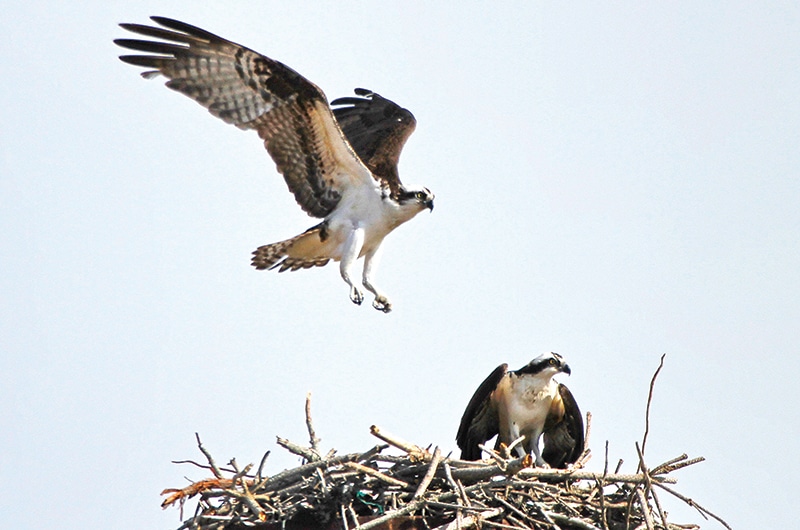Dr. Sarah Treanor Bois
Director of Research & Education at the Linda Loring Nature Foundation
Osprey, (Pandion haliaetus) also known as Fish Hawks, are abundant on Nantucket this time of year. Their calls are familiar along most ponds and wetlands. Their nesting platforms dot the landscape all around the island. While these majestic birds of prey are now a fixture of early spring and summer on the island, that was not always the case.
ROAD TO RECOVERY
If we go back 40 years or more, the story of Osprey is a very different one. Like many birds of prey around this time, their numbers were suffering in large part to DDT and other pesticides. This pesticide was widely used throughout the U.S. and would bioaccumulate through the food chain and be stored in the fatty tissue of the bird. These chemicals were later shown to significantly reduce reproductive success. In New England, and along the Atlantic Coast, the breeding population of Osprey was reduced to 10% of pre- DDT levels.
In 1973, DDT was finally banned and legislation was passed protecting these birds. However, this only protected the birds in the U.S. Shooting of Osprey was another significant factor in their decline. In the 1970s and 1980s, many shooting deaths occurred in the Osprey overwintering grounds in Central or South America. New regulations and education have significantly reduced shootings throughout the Osprey range, however, shootings still occur at fish farms and other areas where Osprey are seen as a pest species.
… AND TODAY
At present, Osprey on Nantucket are a common sight. In fact, their return from overwintering grounds marks the unofficial beginning of spring. Individuals begin to arrive from Central and South America in mid- to late March and immediately start courtship and nest construction. Most of the time the nest miraculously survives the winter, so the Osprey build on top of the old nest.
In the wild, they use dead trees as nest sites. However, since we tend to remove dead trees for safety reasons, we humans now construct nesting platforms for the birds. This also helps them avoid telephone lines, another surrogate for dead trees. On Nantucket there are more than 30 nesting platforms. In a 2016 count, there were 28 nest sites and 16 active nests (eggs laid). The platforms come in a variety of sizes, but generally they are old telephone poles put up with the help of National Grid cherry picker trucks. A flat platform on top offers a good spot for adding sticks and other nesting material.
Osprey have high site fidelity and are loyal to their mates, meaning that they go back to the same nesting site yearly with the same mate. The male typically arrives first and begins adding nesting material back to the nest and defending territory.
Depending upon time of arrival, Osprey will lay 2-4 eggs sometime between April and early May, with hatching occurring in late May or early June. This year, at the Linda Loring Nature Foundation, the Osprey nest visible from the office has already hatched young. While we can’t always see the chicks within the deep nest, the behavior of the adults has gone from incubating to round-the-clock feeding. In Osprey, both parents feed the young, with one parent usually around to defend the nest at all times.
The chicks will fledge in late July and early August. After fledging, the chicks stay with the parents for 2-3 months. This is a great time to observe these amazing birds as there are parents, fledglings, and juveniles flying all around the island.
The Osprey’s diet is 99% fish, so that is why we primarily see them active around our ponds, harbors, and shorelines. They have excellent eyesight, enabling them to spot prey in water from high above.
Unlike many other species, Osprey are able to completely submerge themselves underwater when hunting for prey. Because of this, they have very dense plumage that keeps them from getting soaking wet when diving. They also have specialized nose valves that prevent water from getting up their nostrils when they dive. As soon as the Osprey hits the water, the valves close immediately.
In order to reduce drag while in flight, Osprey have adapted to rotate their fish prey to be parallel with their bodies. This minimizes the force of wind and makes getting back to the nest easier and faster, as it is more aerodynamic. Osprey have two toes that face forward while the other two face backward, allowing them to hold the fish more efficiently. Spicules on their talons act like barbed hooks allowing them to tightly grasp the wiggling fish.
Just like the tourists who flock downtown in the summer, when it starts to get cold in September to November, our Osprey migrate hundreds of miles back to Central and South America. While none of the Nantucket birds are currently tracked, many individuals from along the Atlantic Coast have been outfitted with radio transmitters and/or GPS trackers to aid researchers in understanding more about Osprey migration patterns. Through programs like Animal Tracker and Movebank (movebank.org), you can track migration of Osprey and other species in real time.
There are many places around Nantucket where you can view Osprey and their nests from a safe distance. The Linda Loring Nature Foundation has three nests visible on their property and often has a spotting scope trained on the most visible nest. The Nantucket Conservation Foundation has multiple nests on their properties, most notably Sanford Farm and Eel Point. The Nantucket Land Bank hosts the Jackson’s Point nest in Madaket, which is easily visible by car from the end of Massachusetts Avenue.